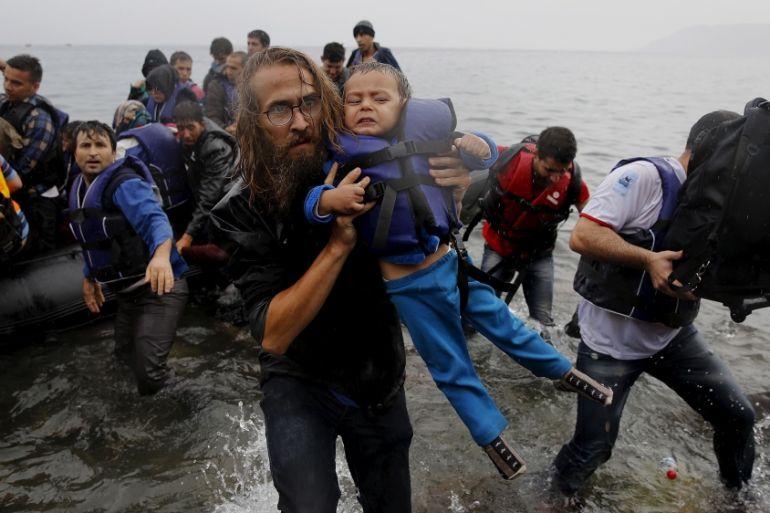Report on child refugees highlights ‘unacceptable’ risk
Risks for child refugees in Europe include trafficking, exploitation, illness, death, according to ombudspersons report.

Amsterdam, the Netherlands – Child refugees face unacceptable risks on their way through Europe. Among these risks are illness, trafficking, exploitation, sexual abuse and even death. European countries are seriously failing to protect these children on the move.
This is the conclusion of a report on the safety of child refugees by the Taskforce on Children on the Move, an initiative of 41 ombudspersons for children from 33 European countries.
Keep reading
list of 4 items‘Mama we’re dying’: Only able to hear her kids in Gaza in their final days
Europe pledges to boost aid to Sudan on unwelcome war anniversary
Birth, death, escape: Three women’s struggle through Sudan’s war
“The rights of refugee children are merely a footnote in the European Union-agenda on migration, whereas they should be at the core of it,” said Marc Dullaert, the chairman of the Network of European Ombudspersons for Children, during the presentation of the report, yesterday in Amsterdam.
|
|
The situation is now all the more urgent, Dullaert said, because the number of child refugees coming to Europe has increased dramatically. In June 2015, 16 percent of all migrants crossing the Mediterranean were children. By December this number had more than doubled to 35 percent.
In 2015, at least 337,000 children were registered as asylum seekers in Europe, but their real number is believed to be much higher.
Dangerous journey
The journey across the Mediterranean is very dangerous for children, according to the report.
One third of all migrants who die during the crossing are children. For the ones who survive a difficult and traumatising journey lies ahead.
“When child refugees arrive in Greece, they are wet and cold,” said Dullaert. “Some suffer from hypothermia, which can lead to serious illnesses like pneumonia. We know of cases where babies died of hypothermia. There is a serious lack of immediate help at the shores in Greece. In Lesbos, for example, refugees have to walk 70km to the reception centre,” Dullaert said.
According to the report, the situation in the transit centres along the Western Balkan route is often deplorable. Only 22 to 45 percent of the centres have been ‘winterised’, which means children have to sleep in unheated tents or sheds at temperatures below zero.
Sanitary facilities are often inadequate. “This is really shameful. We all know that each year there’s a winter. That is a fact of life we can prepare for,” said Dullaert.
|
|
Some children face sexual abuse and violence in the transit centres. At the chaotic border controls children run the risk to be separated from their parents. Unaccompanied children are prone to become victims of trafficking, sexual exploitation or extortion by smugglers. They also run the risk to be placed in detention, in some cases even for several months.
“All these European countries that refugees pass through have signed the European Convention of the Rights of the Child. They cannot turn a blind eye to this situation,” said Dullaert.
A call for action
The report calls upon the European Commission to immediately develop an action plan to protect refugee children. An important practical change would be the improvement of the transit centres on the route through Europe.
![Many of the refugee centres across Europe are not equipped for the winter [Mona van den Berg/Al Jazeera]](/wp-content/uploads/2016/01/fd5ae554418e4c49a26660da3542dc70_18.jpeg)
The centres should be equipped with heating, warm water, blankets and warm clothes. Child-friendly spaces and separate sleeping areas for men and women and children should be created.
On a political level the report urges European countries to an increase the possibilities for family reunification, instead of decreasing them as some states are now trying to do.
Furthermore, the report calls for priority to be given to orphans and families with children in the relocation schemes for the 160,000 refugees who are now in Greece and Italy but need to be redistributed among other European countries.
READ MORE: Child refugees in Macedonia
What the effect of the ombudsperson’s call for action will be, remains uncertain.
“As children’s ombudspersons we cannot force governments to take action,” Dullaert said. “We can only put this issue on the agenda. But we have already been invited to present our report at several important summits. So it will certainly be discussed in the biggest international forums.”
“We are very happy with this report,” said Margot Ende, director of SOS Children’s Villages Netherlands, one of the NGOs setting up child friendly spaces in transit centres in the Balkans.
“This survey draws attention to the problems of child refugees and that is a very good thing. But it remains to be seen if concrete measures will be taken immediately to improve the lot of these children. Many of the problems described in the report have been known for quite some time, and yet so far nothing has been done about it. There really is need for action.”